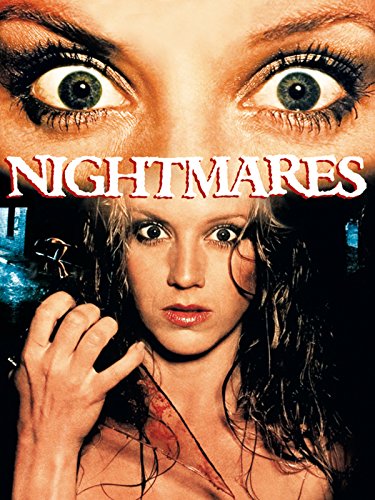

Nightmares (John D. Lamond, 1980) co-prod. wr. Colin Eggleston; Jenny Neumann, Gary Sweet, Nina Landis, Max Phipps, John Michael Howson, Briony Behets, Maureen Edwards, Sue Jones, Jennie Lamond; horror, scifi; memorable entry for the film by Scott Murray in Murray 1995: 64; 82 min. Gothic thriller
A little girl named Cathy tries to keep her mother from making out with a man while driving one day, and she inadvertently causes her mother's death in the car crash. Sixteen years later, Cathy has changed her name to Helen and has become a psychotic actress. Things are going fine until horrible things start to happen with the cast of her new play. (IMDb, corrected)
Here is Scott Murray's entry in full.
Bioscope presents a John Lamond Picture[—]Enterprises Production. NIGHTMARES. © 1980 Movityme. Location: Melbourne. Australian distributor: Roadshow. Opened: November 1980. Video: Roadshow Home Video. Rating: R (October 1980; 2258.93m). 35mm. Panavision. 82 mins.
Producers: John Lamond, Colin Eggleston. Scriptwriter: Colin Eggleston. Based on an original idea by John Lamond and John-Michael Howson. Director of photography: Garry Wapshott. Production designer: Paul Jones. Wardrobe: Aphrodite Kondos, Jan Barkell. Editor: Colin Eggleston. Composer: Brian May. Sound recordist: John Phillips. [Sound editor: not credited.] Mixer: Phil Judd.
Cast
Jenny Neumann (Helen Selleck), Gary Sweet (Terry Besanko), Nina Landis (Judy), Max Phipps (George D’alberg), John-Michael Howson (Bennett Collingswood), Edmund Pegge (Bruce), Sue Jones (Gay), Adele Lewin (Sue), Briony Behets (Angela), Maureen Edwards (Mother), Byron Williams (Father), Peter Tulloch (Brian), Malcolm Steed (Doctor), Denise Peterson (Bad Auditionee), Tania Uren (Policeman No. 1), Gary Day (Policeman No. 2), Joy Westmore (Matron), Lise Rodgers (Mousy Auditionee), Doug Bowles (BabySitter), Rossana Zuanetti (Girl in Lane), Gene Van Dam (Boy in Lane), Angela Menzies-Willis (Lover in Bed).
A small girl walks sleepily down the corridor to her parents’ bedroom. Silently opening the door, she finds her father (Byron Williams) in bed with a blonde (Angela Menzies-Willis). A month later, Cathy and her mother (Maureen Edwards) leave to visit Granny. Cathy falls asleep on the back seat. When she awakes, she notices her mother is kissing a man in the front while driving. When Cathy physically intervenes, the car crashes and Cathy is tossed through the car window (shades of Phil Noyce’s Dead Calm ten years on). After extricating herself from the wreck, Cathy drags her mother away to safety. But a slither of glass catches in her mother’s throat and kills her. So begins the trauma and the nightmares which will continue to haunt Cathy and send her, sixteen years later, on a savage murder spree.
Surprisingly, director John Lamond makes no attempt to pretend anyone but Cathy, now strangely renamed Helen Selleck [2] (Jenny Neumann) and now an actress, is the murderer. Though she is not seen during the killing scenes (it is all wobbly cam and heavy breathing), she has visual flashes of things only the murderer could know.
One result of this don’t-hide approach is that there is no tension in the film. Equally, one knows each potential victim is certainly done for; maybe director John Lamond felt the entertainment comes from watching numerous naked bodies get stabbed or castrated. And even if Lamond never actually shows a glass spike rip into flesh, most viewers will find the murders quite disturbing, especially since most occur during sex.
The only two things that single Nightmares out from the plethora of horror films that would come over the next decade is the characterisation of vile theatre critic Bennett Collingswood (John-Michael Howson). When George D’alberg (Max Phipps), Helen’s theatre director, confronts Bennett after an opening night performance, there is this memorable exchange.
'What lies, slanders and half-truths are you perpetrating tonight, Bennett, in the guise of fair criticism? [...] I suppose you panned us all, you crippled old queen.'
‘Save one shining light'
'Whose knickers you want to get into, no doubt.'
Not only is it rare for a film-maker to rail so vehemently against critics, but many people at the time took Bennett Collingswood to be an attack on the (heterosexual) film reviewer for The Age, Colin Bennett. Bennett angered large sections of the film industry with an intemperate panning of Tim Burstall’s pioneering 2000 Weeks (1969). For this, he was never forgiven (nor for preferring foreign art movies to the oft-crude attempts at commercialism by battling Australian filmmakers).
Every industry has its romans-à-clef but this caricature in Nightmares must rank as one of the most vitriolic.
Scott Murray
1. John D. Lamond dropped the ’D.’ on this film.
2. There is nothing which actually states that Cathy becomes Helen, but Lamond seems to expect us to assume this.
3.Another cause célèbre was the shooting script of Michael Thornhill’s Between Wars (1974) which was reputed to have several outrageous send-ups of staff at the then Australian Film Development Corporation.
Garry Gillard | New: 24 June, 2020 | Now: 24 June, 2020